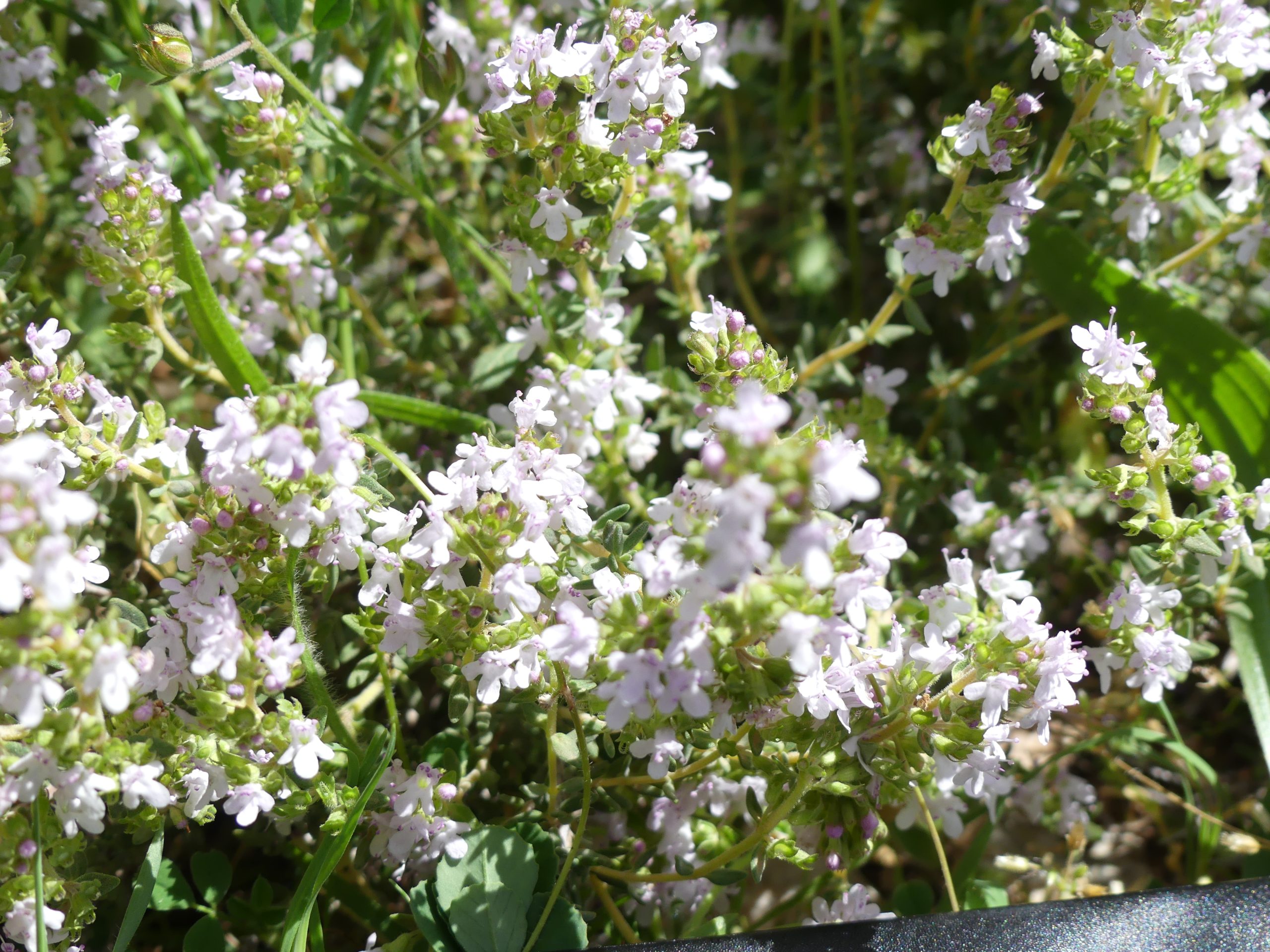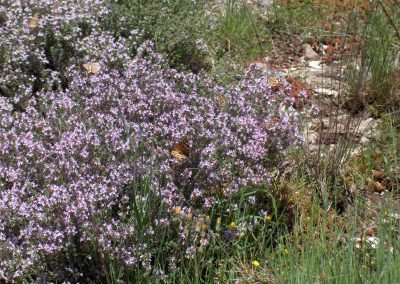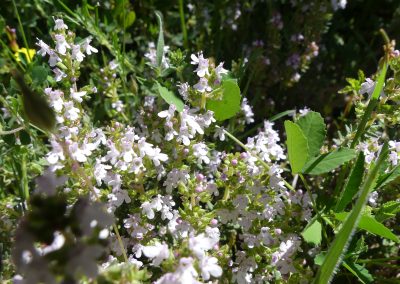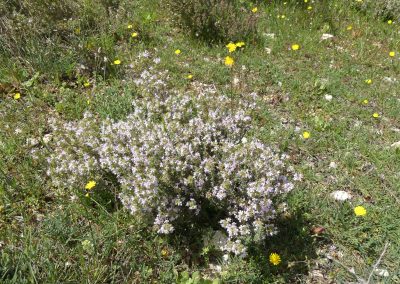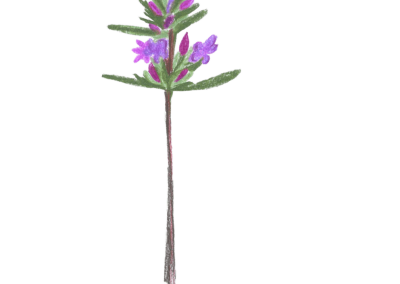Thymus vulgaris
Scientific description
Taxon: Thymus vulgaris L.
Class: Magnoliopsida
Subclass: Asteridae
Order: Lamiales
Family: Lamiaceae
Common name: Common thyme
Origin:
Southern France, Spain, Balearic Islands, Italy.
Description:
Small aromatic shrub, 10–30 cm tall, woody, erect, twisted stems forming a dense bush. Leaves lanceolate, pale green, rolled at edges, with thick white hairs underneath. Flowers white or pinkish, in spikes or globular heads, blooming April to July.
Propagation:
By seeds, cuttings, or division.
Ecology:
Dry, arid, rocky Mediterranean habitats.
Use:
Highly aromatic, used in cooking. Essential oil used for respiratory ailments.
Threat:
Common species, classified as Least Concern nationally.
Taxon: Thymus vulgaris L.
Classe: Magnoliopsida
Sous-classe: Asteridae
Ordre: Lamiales
Famille: Lamiaceae
Nom commun: Thym commun
Origine:
Sud de la France, Espagne, îles Baléares, Italie.
Description:
Petit arbuste aromatique de 10 à 30 cm, tiges ligneuses, dressées et tortueuses, formant un buisson dense. Feuilles lancéolées, vert blanchâtre, enroulées sur les bords, recouvertes dessous d’un épais duvet blanc. Fleurs blanches ou rosâtres en épis ou têtes globuleuses, d’avril à juillet.
Multiplication:
Par semis, bouturage ou division de touffes.
Écologie:
Milieux secs, arides et rocailleux du pourtour méditerranéen.
Utilisation:
Très aromatique, utilisé en cuisine. Huile essentielle employée en phytothérapie pour les troubles respiratoires.
Menace:
Espèce commune, classée en préoccupation mineure dans la liste rouge nationale.
Taxon: Thymus vulgaris L.
Clasă: Magnoliopsida
Subclasă: Asteridae
Ordin: Lamiales
Familie: Lamiaceae
Denumire comună: Cimbru de grădină sau Cimbru comun
Origine:
Sudul Franței, Spania, Insulele Baleare, Italia.
Descriere:
Arbușor aromatic mic, 10–30 cm, tulpini lemnoase, drepte și răsucite, formând un tufiș dens. Frunze lanceolate, verde-albăstrui, răsucite pe margini, acoperite pe partea inferioară cu un puf alb. Flori albe sau roz în spice sau capete globulare, aprilie–iulie.
Propagare:
Prin semințe, butași sau divizarea tufelor.
Ecologie:
Mediu uscat, arid și stâncos în zona mediteraneană.
Utilizare:
Foarte aromat, folosit în bucătărie. Ulei esențial pentru afecțiuni respiratorii.
Amenințare:
Specie comună, clasată cu risc scăzut.
Ταξινόμηση: Thymus vulgaris L.
Κλάση: Magnoliopsida
Υποκλάση: Asteridae
Τάξη: Lamiales
Οικογένεια: Lamiaceae
Κοινή ονομασία: Θυμάρι, Κοινό θυμάρι
Προέλευση:
Νότια Γαλλία, Ισπανία, Βαλεαρίδες Νήσοι, Ιταλία.
Περιγραφή:
Μικρός αρωματικός θάμνος ύψους 10–30 εκ., ξυλώδεις, όρθινοι και σπειροειδείς βλαστοί, σχηματίζουν πυκνό θάμνο. Φύλλα λογχοειδή, πρασινο-λευκά, τυλιγμένα στις άκρες, με πυκνή λευκή τριχόπτωση στην κάτω επιφάνεια. Άνθη λευκά ή ρόδινα σε στάχυες ή σφαιρικές κεφαλές, από Απρίλιο έως Ιούλιο.
Πολλαπλασιασμός:
Με σπόρους, μοσχεύματα ή διαίρεση θάμνων.
Οικολογία:
Ξηρά, άνυδρα και πετρώδη ενδιαιτήματα της Μεσογείου.
Χρήση:
Αρωματικό στη μαγειρική. Αιθέριο έλαιο για αναπνευστικά προβλήματα.
Απειλές:
Κοινό είδος, με χαμηλό κίνδυνο.
Creative writing inspired by Thymus vulgaris
The remedy
It was a sunny day when all the plants were ripening. But there was one that was slow in coming into being. Her name was Thyme. On that beautiful July 14, 2024, Thyme finally showed its face. A few months later, an invasion of wild rats spread through the city. The population was devastated. It was even rumored that if a rat bit someone, the person would die within days. Sadly, this is what happened to his grandmother, who died 3 days after being bitten.
Thyme's tears kept flowing, until one of them fell into his glass, suddenly creating a magic potion. This potion repelled all the rats in town, but that wasn't all it did. It repelled all the bad smells and bacteria of the people.
Thyme has been used ever since as a repellent, but also as a condiment. Indeed, this plant is also very useful in certain dishes such as meats, or barbecue marinades.


